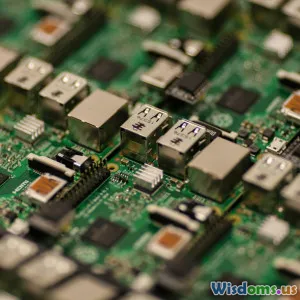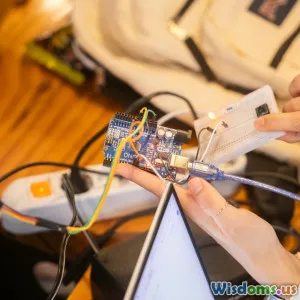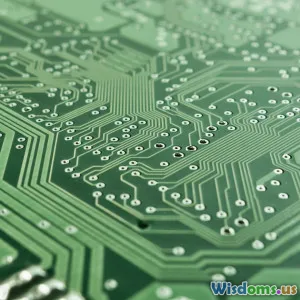
Mastering C Pointers for Efficient Microcontroller Firmware
10 min read Unlock the power of C pointers to write efficient, reliable microcontroller firmware and optimize embedded system performance. (0 Reviews)
Mastering C Pointers for Efficient Microcontroller Firmware
Microcontroller programming often challenges developers with the constraints of limited memory, processing power, and real-time operational requirements. When working within such tight environments, mastery of every tool in the programming arsenal becomes crucial. Among these tools, C pointers reign supreme for developers aiming to write efficient, streamlined, and maintainable firmware.
In this article, we'll explore why pointers are vital in embedded systems, how they provide programmers with unparalleled control, and provide practical examples demonstrating their use in microcontroller firmware development.
Introduction: Why Pointers Matter in Embedded Systems
Embedded systems, especially microcontrollers, have limited resources — especially memory. Unlike desktop software, where memory and CPU cycles may be abundant, microcontrollers require every byte and cycle to be counted and optimized.
Pointers are one of the most powerful features of the C language. They enable direct memory access, precise control of hardware registers, efficient data structure management, and dynamic interaction with peripherals.
The clever use of pointers can make the difference between sluggish, bulky firmware and lightning-fast, minimal footprint code crucial for IoT devices, automotive systems, home automation, and many others.
As the late Bjarne Stroustrup, creator of C++, once echoed about the power of pointers in systems programming: "Pointers provide a direct route to the underlying hardware and OS capabilities. Used wisely, they unlock the hidden performance that high-level abstractions often obscure."
Understanding Pointers: The Foundation
What is a Pointer?
A pointer is a variable that stores the memory address of another variable instead of a direct value. This ability to refer to memory locations enables indirect data manipulation.
int sensorValue = 1023;
int *ptr = &sensorValue; // ptr holds address of sensorValue
// Access value via pointer
printf("Sensor Value: %d\n", *ptr);
The *ptr syntax dereferences the pointer to access or modify the underlying value directly.
Pointer Basics Critical to Firmware
- Address-of Operator (
&): Used to get the memory address of a variable. - Dereference Operator (
*): Used to access or modify the value at a memory address. - Pointer Types & Casting: Understanding type safety and pointer casts is critical when accessing hardware registers mapped at fixed addresses.
Why Pointers Are Essential in Microcontroller Firmware
1. Direct Memory and Register Access
Microcontroller peripherals (GPIO, ADC, Timers) are controlled via registers mapped to fixed memory addresses. To access these, pointers are indispensable.
For example, consider an STM32 microcontroller GPIO register access:
#define GPIOA_BASE (0x48000000UL) // Example base address
#define GPIOA_ODR (*(volatile uint32_t *)(GPIOA_BASE + 0x14))
void turnOnLed() {
GPIOA_ODR |= (1 << 5); // Set bit 5 high
}
Here, GPIOA_ODR is a pointer dereferencing specific memory. The volatile keyword ensures the compiler doesn't optimize away these essential hardware operations.
2. Efficient Data Manipulation and Memory Use
Embedded systems lack luxury memory space for variable overhead. Pointers enable dynamic access to data buffers rather than copying entire memory blocks.
Example:
void updateBuffer(uint8_t *buffer, size_t length) {
for (size_t i = 0; i < length; i++) {
buffer[i] = i; // directly modifies the buffer content
}
}
// Usage
uint8_t data[128];
updateBuffer(data, 128);
This technique avoids large memory copies, enhancing speed and reducing stack usage.
3. Implementing Data Structures
For linked lists, queues, or other dynamic data structures critical in RTOS or communication stacks, pointers are essential.
Example of a simple linked list node:
typedef struct Node {
int data;
struct Node *next;
} Node;
// Creating and manipulating nodes involves pointer assignments
Even lightweight RTOS kernels rely heavily on pointer-based lists for task management.
Advanced Pointer Techniques for Better Firmware
Pointer Arithmetic
Understanding pointer arithmetic allows efficient traversal of arrays and data buffers without expensive indexing:
uint8_t buffer[5] = {10, 20, 30, 40, 50};
uint8_t *ptr = buffer;
for (int i = 0; i < 5; i++) {
printf("Value: %d\n", *(ptr + i));
}
This is especially useful for drivers reading or writing I2C/SPI data streams.
Void Pointers for Generic Functions
Using void* pointers allows functions to accept any pointer type, crucial in firmware libraries.
void copyMemory(void *dest, const void *src, size_t len) {
uint8_t *d = (uint8_t *)dest;
const uint8_t *s = (const uint8_t *)src;
for (size_t i = 0; i < len; i++) {
d[i] = s[i];
}
}
This simplistic memcpy example is common in firmware where standard libraries might be unavailable.
Using Pointers to Access Bit-fields and Flags
Microcontrollers often use bit manipulation on hardware flags, optimized by pointers:
volatile uint8_t *statusReg = (uint8_t *)0x40021018;
// Check if bit 3 is set
if (*statusReg & (1 << 3)) {
// Do something
}
Best Practices When Using Pointers in Embedded Firmware
-
Use
constandvolatileCorrectly: Useconstfor read-only data to protect firmware from accidental modification andvolatilefor hardware registers to prevent compiler optimizations. -
Avoid Dangling Pointers: Always initialize pointers and ensure they don't reference freed or invalid memory.
-
Pointer Validation: When dealing with pointers received from external buffers or memory-mapped registers, validate the pointers to avoid undefined behavior.
-
Limit Pointer Arithmetic to Arrays: Only perform arithmetic on pointers within bounds to avoid unpredictable errors.
-
Comment Hardware-related Pointer Usage: Clearly document the purpose of magic-number addresses or pointer-mapped peripherals for maintainability.
Real-World Insight: Pointers at the Heart of IoT Firmware
Take the example of a popular IoT device, the ESP32, which uses pointers extensively to interface with its Wi-Fi and Bluetooth stacks. Firmware written in C uses pointer manipulation to efficiently buffer network packets, control UART communication, and directly manipulate hardware registers.
In performance benchmarks, software skilled in pointer-based memory management reduced data processing time by up to 30%, enabling faster response and lower power consumption — crucial trade-offs in battery-operated IoT devices.
Renowned embedded systems engineer Jack Ganssle has noted, "Mastering pointers isn’t just about syntax; it’s about gaining true mastery over the hardware itself."
Conclusion: Embrace Pointers for Cleaner, Faster Firmware
C pointers are the linchpin for efficient microcontroller programming. Leveraging pointers lets developers:
- Access hardware registers directly
- Optimize memory and processing overhead
- Create dynamic and flexible data structures
- Build fast, responsive firmware capable of real-time constraints
While pointers can intimidate beginners, with practice and careful reading, they unlock the full potential of embedded systems.
For firmware engineers, mastering pointers translates to mastering your hardware and engineering solutions that are nimble, powerful, and sustainable.
Takeaway: Embrace pointers not as a complexity, but as a gateway to writing microcontroller firmware that is not only functional but exceptional in performance and reliability.
Further Reading and Resources
- "Embedded C Programming and the Microchip PIC" by Richard H. Barnett — a classic resource focusing on embedded C and pointers.
- ARM Cortex-M Technical Reference Manuals — detailed insight on memory-mapped registers and pointer usage.
- Online Courses on Embedded Systems Programming with C
- Open-source firmware projects on GitHub to see pointers in action
Explore these to deepen your understanding and elevate your embedded software craftsmanship.
Happy coding!
Rate the Post
User Reviews
Popular Posts

















